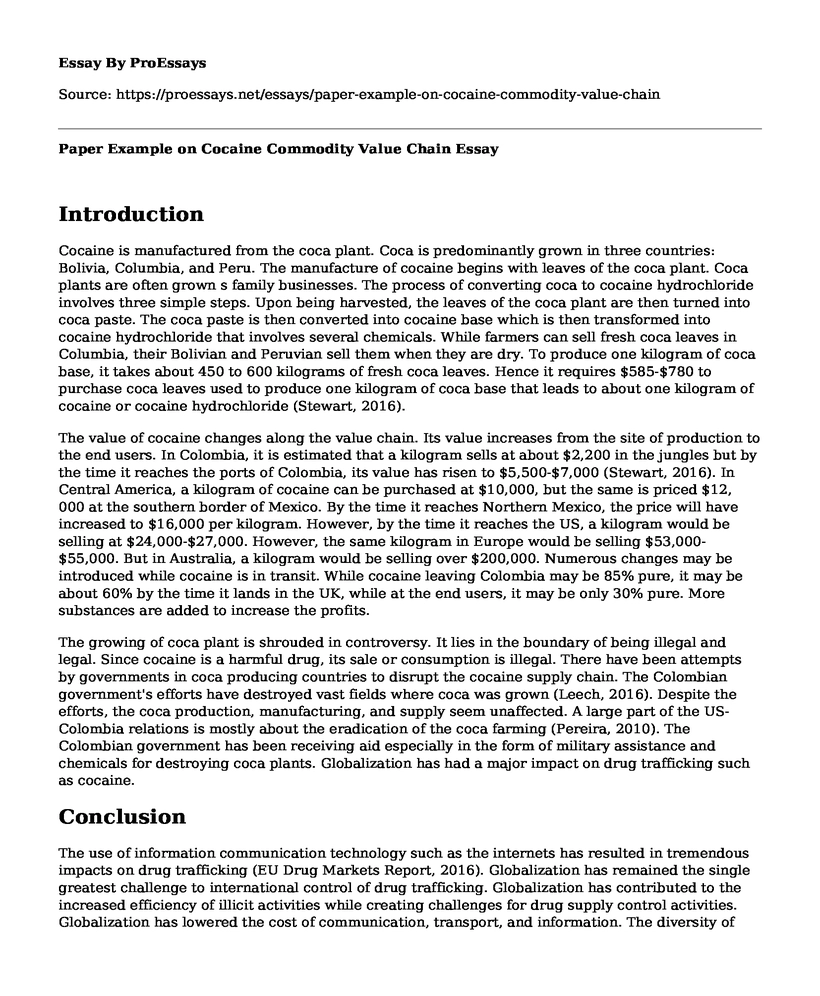Introduction
Cocaine is manufactured from the coca plant. Coca is predominantly grown in three countries: Bolivia, Columbia, and Peru. The manufacture of cocaine begins with leaves of the coca plant. Coca plants are often grown s family businesses. The process of converting coca to cocaine hydrochloride involves three simple steps. Upon being harvested, the leaves of the coca plant are then turned into coca paste. The coca paste is then converted into cocaine base which is then transformed into cocaine hydrochloride that involves several chemicals. While farmers can sell fresh coca leaves in Columbia, their Bolivian and Peruvian sell them when they are dry. To produce one kilogram of coca base, it takes about 450 to 600 kilograms of fresh coca leaves. Hence it requires $585-$780 to purchase coca leaves used to produce one kilogram of coca base that leads to about one kilogram of cocaine or cocaine hydrochloride (Stewart, 2016).
The value of cocaine changes along the value chain. Its value increases from the site of production to the end users. In Colombia, it is estimated that a kilogram sells at about $2,200 in the jungles but by the time it reaches the ports of Colombia, its value has risen to $5,500-$7,000 (Stewart, 2016). In Central America, a kilogram of cocaine can be purchased at $10,000, but the same is priced $12, 000 at the southern border of Mexico. By the time it reaches Northern Mexico, the price will have increased to $16,000 per kilogram. However, by the time it reaches the US, a kilogram would be selling at $24,000-$27,000. However, the same kilogram in Europe would be selling $53,000-$55,000. But in Australia, a kilogram would be selling over $200,000. Numerous changes may be introduced while cocaine is in transit. While cocaine leaving Colombia may be 85% pure, it may be about 60% by the time it lands in the UK, while at the end users, it may be only 30% pure. More substances are added to increase the profits.
The growing of coca plant is shrouded in controversy. It lies in the boundary of being illegal and legal. Since cocaine is a harmful drug, its sale or consumption is illegal. There have been attempts by governments in coca producing countries to disrupt the cocaine supply chain. The Colombian government's efforts have destroyed vast fields where coca was grown (Leech, 2016). Despite the efforts, the coca production, manufacturing, and supply seem unaffected. A large part of the US-Colombia relations is mostly about the eradication of the coca farming (Pereira, 2010). The Colombian government has been receiving aid especially in the form of military assistance and chemicals for destroying coca plants. Globalization has had a major impact on drug trafficking such as cocaine.
Conclusion
The use of information communication technology such as the internets has resulted in tremendous impacts on drug trafficking (EU Drug Markets Report, 2016). Globalization has remained the single greatest challenge to international control of drug trafficking. Globalization has contributed to the increased efficiency of illicit activities while creating challenges for drug supply control activities. Globalization has lowered the cost of communication, transport, and information. The diversity of flows has been increased by globalization, while it has also facilitated the transfer of technological know-how needed in the processing of the drug. With increased efficiency, there has been a drop in the price at the end user, and this has stimulated consumption.
References
EU Drug Markets Report. (2016). Influence of globalization. Retrieved from http://www.emcdda.europa.eu/publications/eu-drug-markets/2016/online/drivers/influence-of-globalisation_en
Leech, S. (2016, October 30). Economics of cocaine. Market Mogul. Retrieved from https://themarketmogul.com/the-economics-of-cocaine/
Pereira, L. (2010). Becoming coca: A materiality approach to a commodity chain analysis of hoja de coca in Colombia. Singapore Journal of Tropical Geography, 31, 384-400.
Stewart, S. (2016, June 27). From Colombia to New York City: The narconomics of cocaine. Business Insider. Retrieved from www.businessinsider.com/from-colombia-to-new-york-city-the-economics-of-cocaine-2015-7?IR=T
Cite this page
Paper Example on Cocaine Commodity Value Chain. (2022, Jul 27). Retrieved from https://proessays.net/essays/paper-example-on-cocaine-commodity-value-chain
If you are the original author of this essay and no longer wish to have it published on the ProEssays website, please click below to request its removal:
- Mobile Phone Addiction Paper Example
- Should Teachers Be Allowed to Carry Firearms in the Classroom? - Controversial Essay
- Essay Sample on Causes of the Financial Crisis
- Salary Gap for Females in the Media Industry Essay Example
- Essay Example on Casual Employment in Australia
- Essay Sample on Mexican American Women's Rebellion Against Social Conventions During WWII
- Free Essay Sample on Deaths by Firearms: Prevalence, Injury, and Prevention







